UTK Environmental Health & Safety Program HM-001
The purpose of this is to serve as the written program for hazard communication for the UTK campus.
Effective Date: 01/01/2009
Revision Date: 09/27/2017
Purpose
The purpose of this document is to ensure that the hazards of chemicals used in the workplace are evaluated, and those hazards are communicated to both employers and employees. In addition, the purpose is to minimize hazardous exposure to chemicals and to provide information to emergency personnel, as required by TOSHA’s Hazard Communication Right-to-Know Standard and the Occupational Exposure to Hazardous Chemicals in the Laboratory Standard.
This document does not detail the requirements of the Laboratory Standard regarding Chemical Hygiene Plans. Please refer to the Chemical Hygiene Plans document in the campus Safety Manual for more information.
Scope and Applicability
This procedure applies to all chemicals known to be present in the workplace such that employees can be exposed under normal conditions of use or in a foreseeable emergency.
This shall apply to all places of employment on the UTK campus where students, staff and faculty are exposed or potentially exposed to a hazardous chemical hazard(s).
Where chemicals are used in a manner that meets the definition of “laboratory use” (see definition below), the Chemical Hygiene Plan program will be used (see Chemical Hygiene Plans document in the UTK Safety Manual). Where chemicals are used in a laboratory but do not meet the definition of “laboratory use”, the UTK Hazard Communication Program shall apply.
Abbreviations and Definitions
Abbreviations
GHS: Global Harmonization System
HCS: Hazard Communication Standard (often referred to as HazCom)
OSHA: Occupational Safety and Health Administration
MSDS: Material Safety Data Sheets {as of 2015 MSDSs have been replaced by SDSs}
NFPA: National Fire Protection Association
PPE: Personal Protective Equipment
SDS: Safety Data Sheets
TOSHA: Tennessee Occupational Safety and Health Administration
Definitions
Hazard Communication: The means through which employers inform their employees about hazards in the workplace (i.e. training, labeling, safety data sheets, etc.), which are regulated by the OSHA Hazard Communication Standard, 29 CFR 1910.1200
Hazard Communication does not apply to:
- Cosmetics
- Tobacco Products
- Wood or wood products
- Food or alcoholic beverages
- Drugs
- Biological hazards
- Radiation hazards
- Pesticides
- Articles, as defined in 29 CFR 1910.1200(c)
Articles are essentially finished products. While the materials used to manufacture a plastic bottle may have hazards, once it becomes a bottle, it is an “article”.
Hazardous substance: Any substance that is capable of causing an acute or chronic health condition in humans or adversely impacting the environment. Substances that are considered physical hazards (flammable substances, explosives, shock sensitive, etc.) are included in the definition of a hazardous substance. The OSHA Hazard Communication Standard, 29 CFR 1910.1200 and the OSHA Chemical Hygiene Plan 29 CFR 1910.1450 are the two main standards that define a hazardous substance.
Employee: A worker who may be exposed to hazardous chemicals under normal operating conditions, or in foreseeable emergencies.
Employer: A person engaged in a business where chemicals are either used, distributed, or are produced for use or distribution, including a contractor or subcontractor.
Global Harmonization System: developed by the United Nations as an international standardized approach to hazard communications. This ensures that chemical hazard communication is consistent on a global scale. It is commonly referred to as GHS.
Laboratory Use: “Laboratory use of hazardous chemicals” means handling or use of such chemicals in which all of the following conditions are met:
- Chemical manipulations are carried out on a “laboratory scale” (i.e., work with substances in which the containers used for reactions, transfers, and other handling of substances is designed to be easily handled by one person);
- Multiple chemical procedures or chemicals are used;
- The procedures involved are not part of a production process, nor do they in any way simulate a production process; and
- “Protective laboratory practices and equipment” are available and in common use to minimize the potential for worker exposure to hazardous chemicals.
Safety data sheet (SDS): Formally known as Material Safety Data Sheets (MSDS): Detailed information bulletin prepared by the manufacturer or importer of a chemical that describes the physical and chemical properties, physical and health hazards, routes of exposure, precautions for safe handling and use, emergency and first aid procedures, and control measures.
Regulatory Basis
Hazard Communication Standard (HCS)
In 1983, OSHA adopted the Hazard Communication Standard. The Hazard Communication standard is often called the “Right-to-Know” law, or HazCom. Under the HazCom standard, all employees have a right and a need to know:
- What chemicals you are exposed to
- The hazards of working with these chemicals
- What steps employees can take to protect themselves and those they work with
Integration of the Globally Harmonized System of Hazard Communication (GHS):
In March 2012, OSHA integrated components of the GHS with the existing Hazard Communication Standard (HCS). The GHS standard was developed by the United Nations and is already used in several countries around the world. OSHA incorporated portions of the GHS into the HazCom standard so that container labeling, SDS (formally MSDS) content and format, and chemical hazard determinations are standardized and consistent from workplace to workplace.
Components of HazCom (1910.1200)
There are five components of the HazCom standard (1910.1200) that UTK must comply.
- Written program
- Chemical inventory
- Labeling
- Safety Data Sheets
- Training
These components are detailed in the Procedures section below.
Roles and Responsibilities
Chemical Users (employees) shall:
- Be trained before they work with, use, or handle hazardous chemicals upon initial employment and when new hazardous chemicals are introduced. Refresher training shall be conducted annually and documented appropriately for all employees.
- Stay informed about the hazards of any chemicals known to be present in their workplace, and work with those chemicals in a safe manner.
- Know how to protect themselves from adverse effects of chemicals.
- Ensure all containers are properly labeled.
- Notify their supervisor as soon as possible after exposure to a hazardous chemical in the workplace.
Chemical Users in Laboratories shall:
Follow the plans and procedures outlined in the Chemical Hygiene Plan Program. Laboratory workers are expected to receive basic training and information on this program via their general lab safety training.
Responsible Units
(e.g. Departments; Department Heads, Directors)
whose employees use hazardous chemicals under their control shall:
- Ensure their non-laboratory employees are trained on the Hazardous Right-to-Know Standard, and the UTK Hazard Communication procedure and that they post adequate notification informing the employees of their rights under the TOSHA Hazardous Right-to-Know Law by providing a copy of the “You Have a Right to a Safe and Healthful Workplace” TOSHA poster.
- Ensure their laboratory employees are trained on the Occupational Exposure to Hazardous Chemicals in the laboratory standard and the UTK Hazard Communication program.
- Determine the required personal protective equipment needed in their work area and ensure their employees are properly trained in the use of that equipment.
- Ensure that the proper PPE is made available to their employees.
- Assure that all hazardous chemicals that enter or leave the workplace are properly labeled, tagged, or marked in a manner which complies with the Hazardous Right-to- Know Law, and does not conflict with any other regulation pertaining to hazardous materials.
- Develop safe procedures for work in their areas, as well as written procedures for emergencies.
- Ensure that a procedure exists to review and update label information.
- Ensure that a current chemical listing (inventory) is maintained according to the UTK Chemical Inventory program.
- Ensure all employees have access to Safety Data Sheets and are informed of any hazards related to chemicals they will use in their work space. This can be done by either hard copies, or via an electronic format, as long as the employees are properly informed and trained to access them. They must be an assurance that they can operate the system and they have access to the SDS at all times.
- Ensure that any students, contractors, sub-contractors, vendors, salesperson(s), or visitors are informed of any hazardous chemicals used in the areas being visited, or where a person will be working. These people will be provided, or required to provide personal protective equipment for their safety.
- At least once per year, the employer will forward a statement to EHS certifying that all applicable employees have been properly trained, and will maintain all training records for at least 30 years.
- Ensure that EHS is receiving hard copies of SDS for any new chemicals ordered in their work area.
- Make sure that specific training is provided for non-routine tasks.
- Deal with employee exposure to hazards immediately and take steps as necessary to provide medical evaluation, monitoring, or treatment.
- Ensure that all employees have been trained on the new GHS standards that OSHA has incorporated into the Hazard Communication Standard by December 2013.
EHS shall:
- Serve as a technical resource for questions and comments regarding the Hazard Communication standard.
- Coordinate, audit, and determine compliance of UTK’s Hazard Communication Program.
- Maintain a backup library of hardcopy Safety Data Sheets and provide ready access to SDS during an emergency (accidental release).
- Provide the fire chief with a copy of the chemical inventory, SDS, and the names and phone numbers of the representatives who can be contacted for information during an emergency situation involving hazardous chemicals.
- Submit necessary reports to regulatory agencies.
- Provide Hazard Communication training opportunities to campus.
- Revise the UTK campus written hazard communication program as necessary.
- Manage the campus chemical inventory.
Visitors shall:
- Be provided, or required to provide safety and personal protective equipment for their use.
- Notify UTK of the hazards of any chemicals they are delivering or using while on campus.
- Disclose health hazards and fire protection information for any trade secrets, which will be protected.
- Comply with OSHA’s Hazard Communication Standard and with UTK’s hazard communication program.
Procedures
Below is a description of each of the five hazard communication components and the changes to these categories due to GHS.
Written Program
UTK’s written Hazard Communication program covers how the HazCom program will be implemented at UTK. This program assures that all aspects of HazCom have been addressed. UT Knoxville’s written Hazard Communications plan can be found on the EHS web-site at: www.ehs.utk.edu , or by contacting EHS at 865-974-5084.
All responsible units, where laboratory chemical use occurs, are required to maintain an up-to-date Chemical Hygiene Plan, which should include a comprehensive set of basic rules and procedures for the safe use of hazardous chemicals established and documented for their specific work area. See the Chemical Hygiene Plans document in the Safety Manual for more information.
Chemical Inventory
An electronic or paper copy of a chemical inventory of each hazard chemical normally used or stored in the workplace must be compiled and maintained. UTK compiles their chemical inventory on the EHS web-site at http://www.pp.utk.edu/ChemInv/, and EHS has a procedure for maintaining the chemical inventory on this web-site (Chemical Inventory Procedure). The inventory must be updated at least annually and anytime revised information is made available and the currency of the information will be checked at a minimum of once/year. All employees who are using or exposed to any hazardous chemicals on the inventory must have access to the inventory. The inventory must include both containerized and non-containerized hazardous substances (i.e. dusts, exhaust fumes, etc.). If the chemical is not hazardous, then it should not be included in the chemical inventory. Please refer to UTK’s procedure on chemical inventories for more information.
Labels
OSHA’s HazCom standard requires that hazard warning labels must be placed on every container of hazardous chemicals in the workplace. Labels must be legible, in English, and prominently displayed. All containers containing hazardous materials must be properly labeled or marked with the following required information:
Manufacturer Labels
- Product Identifier: name or number used on the label and the SDS. It can be a chemical name, a product name, or some other identifier that helps locate the SDS quickly.
- Signal Word: used to alert the user to a potential hazard and is determined by the hazard class and category of the chemical. There are two signal words used:
- Danger-more severe hazards
- Warning-less severe hazards
- Hazard Statements: standardized phrases assigned to a specific hazard class and category. They are used to describe the nature and the degree of hazard. Examples include: “causes serious eye damage” and “fatal if swallowed”.
- Precautionary Statements: standardized phrases assigned to a specific hazard class and category. There are four types of precautionary statements, covering prevention, response in case of accidental spills and exposure, storage and disposal. Examples include: “wear protective gloves/protective clothing” and “store locked up”.
- Supplier Information: refers to the name, address and telephone number of the chemical manufacturer, importer, or other responsible party.
- Pictograms: a symbol on a white background with a red border that conveys specific information about the hazards of a chemical. There are a total of nine pictograms:
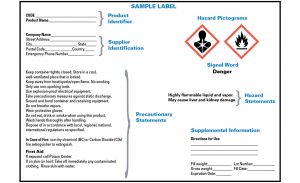
This image displays the six key elements of a GHS compliant primary chemical label. Those elements include the following. Product Identifier: name or number used on the label and the SDS. It can be a chemical name, a product name, or some other identifier that helps locate the SDS quickly. Signal Word: used to alert the user to a potential hazard and is determined by the hazard class and category of the chemical. There are two signal words used: Danger-more severe hazards Warning-less severe hazards Hazard Statements: standardized phrases assigned to a specific hazard class and category. They are used to describe the nature and the degree of hazard. Examples include: “causes serious eye damage” and “fatal if swallowed”. Precautionary Statements: standardized phrases assigned to a specific hazard class and category. There are four types of precautionary statements, covering prevention, response in case of accidental spills and exposure, storage and disposal. Examples include: “wear protective gloves/protective clothing” and “store locked up”. Supplier Information: refers to the name, address and telephone number of the chemical manufacturer, importer, or other responsible party. Pictograms: a symbol on a white background with a red border that conveys specific information about the hazards of a chemical. There are a total of nine pictograms:
Departments receiving containers without appropriate form of warning should take action to have the material returned or obtain a label from the manufacturer, importer or purchase a label.
Portable or Secondary Container Labels
Portable or secondary containers do not have to be labeled if it is intended only for immediate use (on that shift), will be used up by the employee who transfers the chemical from one container to another container, and the container remains in his/her custody at all times. If all three criteria are not met, the container must be appropriately labeled.
A portable or secondary container label must have two parts:
- The identity of the chemical
- Some indication of the hazard
Labels must be cross- referenced with the SDS and the chemical inventory entry, and must be written in English. They must be placed on a prominent area of the container. Employers can label the container in another language, but the information must be presented in English as well. EHS recommends the use of GHS labels on secondary containers, but this is not a requirement, as long as the required information present. Regardless of the type of labeling system selected, the employer must ensure that employees are fully aware of the hazards and understand the labeling system.
Other labeling and signage
Other labeling and signage may be required to communicate hazards in work areas, such as NFPA 704 diamonds or laboratory door placards (EHS Lab Door Placard policy LS-010 for more information).
Hazard Communication Pictograms
The following pictograms are used in manufacturer/importer labels and can be used to support secondary container labeling (i.e. indication of hazard).
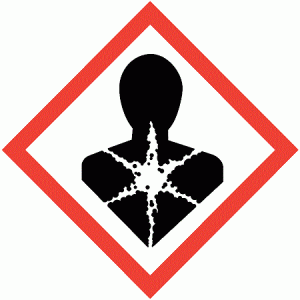 |
Health Hazard· Carcinogen · Mutagenicity · Reproductive Toxicity · Respiratory Sensitizer · Target Organ Toxicity · Aspiration Toxicity |
 |
Flame· Flammables · Pyrophorics · Self-Heating · Emits Flammable Gas · Self-Reactives · Organic Peroxides |
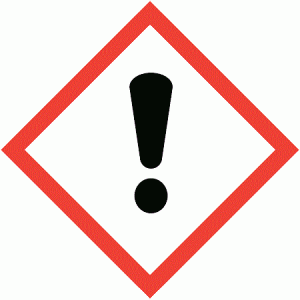 |
Exclamation Mark· Irritant (skin and eye) · Skin Sensitizer · Acute Toxicity (harmful) · Narcotic Effects · Respiratory Tract Irritant · Hazardous to Ozone Layer (Non-Mandatory) |
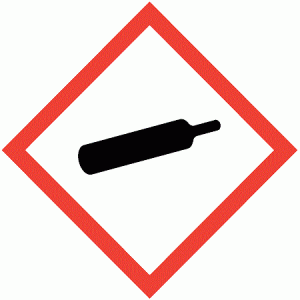 |
Gas Cylinder· Gases under Pressure |
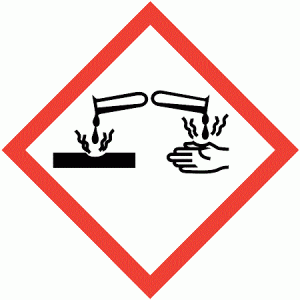 |
Corrosion· Skin Corrosion/Burns · Eye Damage · Corrosive to Metals |
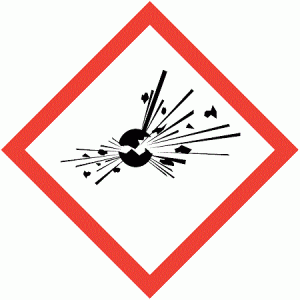 |
Exploding Bomb· Explosives · Self-Reactives · Organic Peroxides |
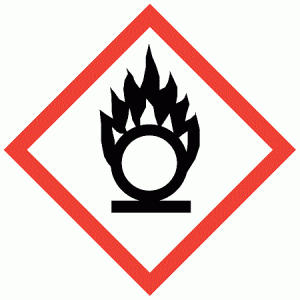 |
Flame Over Circle· Oxidizers |
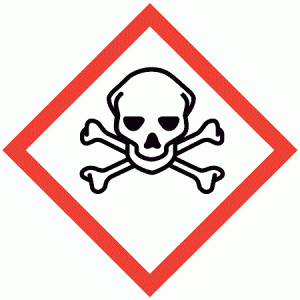 |
Skull and Crossbones· Acute Toxicity (fatal or toxic) |
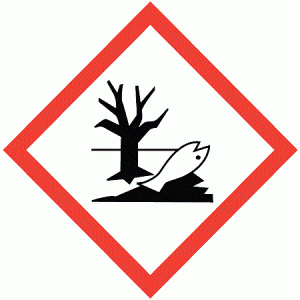 |
Environment (non-mandatory)· Aquatic Toxicity
|
Safety Data Sheet (SDS)
The SDS must be readily available at all times to all personnel using hazardous chemicals. If there is difficulty in obtaining an SDS, the requestor must contact the supplier and/or manufacturer for the SDS. The department head must request the SDS in writing from the manufacturer or distributor within (5) business days. If the SDS is not made available, the employee has a right to refuse to work with that hazardous chemical without retaliation. A person in the work area should be designated as the responsible person to ensure there are copies of SDS for every chemical used and stored in the workspace.
The policy of UTK is to maintain a file of Safety Data Sheets (SDSs) in each work unit that corresponds to the inventory of hazardous chemicals in that respective work area. SDSs may be maintained in a notebook, or electronically as long as the method is reliable, readily accessible, workers are properly trained in the use of those systems, and there is an adequate backup system.
A master file of all data sheets will be maintained in the files of EHS. This master file of SDSs will be made available upon request during normal working hours, 8:00am to 5:00pm, M-F, by calling 974-5084. During an emergency situation and at times other than normal working hours, individuals can contact the University Police Department at 974-3111 who will have available a current listing of organizations capable of providing emergency management assistance and information.
The Safety Data Sheets are designed to provide information concerning the physical and health hazards of chemicals found in the workplace. OSHA now requires that all SDSs must follow a specified 16-section format. An SDS is composed of the following sections, which should be covered in employee training:
- Identification
- Hazard(s) identification
- Composition/information on ingredients
- First-aid measures
- Fire-fighting measures
- Accidental release measures
- Handling and Storage
- Exposure controls/personal protection
- Physical and chemical properties
- Stability and reactivity
- Toxicological information
- Ecological information
- Disposal considerations
- Transport information
- Regulatory information
- Other information
Training and Information
EHS shall provide information to chemical users about this program, including deadlines and format for submittal.
Each person who handles or uses hazardous chemicals shall be trained before they work with, use, or handle hazardous chemicals
- Upon initial employment and
- When new hazardous chemicals are introduced
Refresher training shall be conducted annually and documented appropriately for all employees. All training must be documented by the supervisor.
Required training topics (for non-laboratory workers)
Hazard Communication Standard
Defining the hazard communication standard, the reasons why the standard was written, and the employees’ rights under the standard.
Written Program (this document)
Explanation of the existence of the written plan and how each employee has a right to review the document
Chemical Inventory
Explanation of the requirement for conducting periodic chemical inventories.
Chemical Container Labeling
- Primary Container requirements (Manufacturer/Importer label
- Product Identifier,
- Pictograms
- Signal Words
- Hazard Statements
- Precautionary Statements
- Manufacturer Contact information
- Secondary Container requirements (those containers in which a worker may use or dispense chemicals)
- Product identity
- Some indication of the hazards
Safety Data Sheets (SDS)
Explanation of the requirement that a Safety Data Sheet (SDS) be procured for each hazardous chemical. Advising where the sheets are kept in the unit and exactly how an employee can arrange to review the sheets. An orientation relative to the information available from the SDS.
TOSHA Inspections Questions
A discussion of the types of questions to which a properly trained employee should be able to effectively respond. TOSHA will expect employees to verbally recall answers to the following questions in simple language:
- What are the requirements of the hazard communication standard?
- What hazardous chemical(s) are you exposed to, or may be exposed to, during normal use or in a foreseeable emergency?
- Where is this chemical present?
- What are the short and long term effects on the body, as well as the simple asphyxiant, combustible dust, and pyrophoric gas hazards of the chemical?
- How can you detect if you are overexposed to the chemical(s)?
- How can you protect yourself from overexposure?
- Where are the SDS, chemical list, and written program located?
- What information must be on the label on containers of hazardous chemicals?
- What do the pictograms indicate?
Employees with potential for exposure to hazardous chemicals shall receive job-specific training in addition to that previously listed including:
- Special emphasis on chemicals listed as carcinogenic.
- Methods/observations used to detect the presence or release of hazardous chemicals.
- Procedures, techniques and protective equipment to prevent exposure.
The training format selected to present the orientation and review sessions will be selected such that maximum effectiveness of communication is achieved. Depending on the evaluation of the comprehension capability of the group to be trained, an appropriate combination of training modes to include audiovisuals, classroom instruction, small group discussion, one on one individualized instruction, on-the-job demonstrations, etc. will be employed.
Specific training for non-routine tasks will be dictated by the situation and evaluated thoroughly in accordance with past experience and knowledge of that situation.
Required training topics (for Laboratory Workers)
Laboratory workers do not directly relate to the Hazard Communication Standard for laboratory use of chemicals. The method for training workers in the laboratory use of hazardous chemicals is via a different path. This path includes general hazard communication knowledge and skills through General Lab Safety training and specifically via regular and ongoing training and familiarization with the practices outlined in their respective Chemical Hygiene Plans.
General
UTK does require General Lab Safety Training for all who work in labs (See the Laboratory Health & Safety Policy; LS-001). If researchers work with hazardous chemicals, then training on the five essential components of the hazard communication program is required. They include:
- Written program
- Chemical inventory
- Labeling
- Safety Data Sheets
- Training
This shall also include training on the concepts of the Globally Harmonized Standard (GHS) as adopted in the Hazard Communication Standard (HCS).
- Safety Data Sheets
- Label requirements
- GHS Pictograms
Specific
Training on their lab-specific Chemical Hygiene Plans (see the Chemical Hygiene Plan document for details).
Recordkeeping
Starting in 2008 the University’s central archived chemical inventories shall be kept for at least 30 years. These records may be kept in electronic or hard copy form.
Material safety data sheets must be kept indefinitely.
An individual training record shall be maintained for each employee and kept for period of employment + 5 years. This should contain:
- List of each chemical used or handled by the employee.
- Date of training on hazardous chemicals.
- A signature of the employee showing training on each chemical used or handled by that employee.
References
OSHA: 29 CFR 1910.1200, 29 CFR 1926.59, 29 CFR 1910.1450 (Lab Standard), and TDL
Rule 0800-1-9
NFPA: 45, 306, 654, 49
EPA: 40 CFR 171, 172, 173, 177, 259, 260, 261, 262, 265, 265.16, 268, 302, 302.4, 303, 311,
355, 383, 392, 395, 397, 761
TOSHA: Act of 1972 50-3-101: 50-3-919
Appendices
Hazard Communication Training Record
Disclaimer
The information provided in these guidelines is designed for educational use only and is not a substitute for specific training or experience.
The University of Tennessee Knoxville and the authors of these guidelines assume no liability for any individual’s use of or reliance upon any material contained or referenced herein. The material contained in these guidelines may not be the most current.
This material may be freely distributed for nonprofit educational use. However, if included in publications, written or electronic, attributions must be made to the author. Commercial use of this material is prohibited without express written permission from the author.
Appendices
HM-001 Hazard Communication Downloadable pdf of the complete document
Appendix A: HazCom Training Record